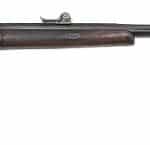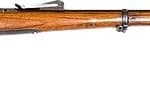
Introduction: A Rifle that Defined an Empire
Few firearms are as deeply intertwined with the expansion of the British Empire as the Martini-Henry rifle. Introduced in the early 1870s, it became the standard service rifle of British forces during the height of Victorian military campaigns. Rugged, powerful, and innovative for its time, the Martini-Henry brought together the precision engineering of Swiss inventor Friedrich von Martini and the rifling brilliance of Scottish gunsmith Alexander Henry. Together, their innovations birthed a weapon that would dominate colonial battlefields, write chapters in history books, and become an enduring icon of 19th-century British military might.
From the burning sun of Zululand to the icy frontiers of Afghanistan, the Martini-Henry was more than a rifle—it was a symbol of authority and technological superiority, anchoring British infantry doctrine during a transitional period in firearm evolution.
Origins and Engineering Innovation
The Search for a Successor
Following the Crimean War and the Indian Rebellion of 1857, it became clear to the British military that muzzle-loading rifles, such as the Enfield Pattern 1853, were no longer sufficient for the rigors of modern warfare. The stopgap solution, the Snider-Enfield—a breech-loading conversion of the 1853 model—was a vast improvement, but by the late 1860s, the War Office recognized the need for a purpose-built, breech-loading service rifle.
In 1869, after a lengthy evaluation process involving numerous competing designs, the British military adopted the Martini-Henry. This rifle successfully combined the Martini falling-block action with Henry’s precision polygonal rifling, producing a firearm that was fast to load, easy to maintain, and exceptionally accurate for its era.
Falling Block Action and Rifling
The Martini action was a single-shot, lever-operated, falling-block mechanism. Lowering the under-lever dropped the breechblock, exposing the chamber for a new cartridge to be manually inserted. Raising the lever locked the breech and cocked the internal striker, readying the rifle to fire. This allowed for a firing rate of 10–12 rounds per minute in trained hands—impressive for the time and a tactical edge over muzzle-loaders.
Alexander Henry’s rifling system was another critical advancement. Featuring seven-groove, right-hand twist polygonal rifling, it imparted excellent spin stability to the heavy lead projectiles, significantly improving long-range accuracy over prior designs.
Manufacturing and Variants
Production Scale and Locations
The Martini-Henry was primarily produced at the Royal Small Arms Factory (RSAF) in Enfield, though massive demand led to the involvement of contractors such as the Birmingham Small Arms Company (BSA), the London Small Arms Co., and others. Exact production figures remain imprecise due to serial number overlaps, conversions, and parts reuse, but most estimates place total production at or near one million rifles between 1871 and 1889.
Notable Variants
Several marks (or models) of the Martini-Henry were produced:
- Mark I (1871) – Initial production model, featuring a long service life but quickly followed by refinements.
- Mark II (1877) – Strengthened action, improved extractor, and minor dimensional changes.
- Mark III (1879) – Redesigned for simplicity in manufacture and better reliability.
- Mark IV (1888) – Converted rifles using older Enfield-Martini or Martini-Enfield components.
Additional carbine versions were also produced for artillery units and cavalry, reflecting the versatile needs of British armed forces during colonial expansion.
The .577/450 Cartridge: Black Powder Thunder
The Martini-Henry was chambered for the .577/450 Martini-Henry cartridge—a bottle-necked, black powder round adapted from the earlier .577 Snider case. It fired a heavy .450-inch lead bullet, weighing approximately 480 grains, propelled by 85 grains of black powder. Muzzle velocity ranged from 1,300 to 1,400 feet per second, with muzzle energy exceeding 1,600 foot-pounds.
Despite the inherent limitations of black powder—fouling, smoke, and trajectory arc—the cartridge was devastating within its intended combat range. The effective range was officially listed as 400 yards for aimed fire, though volley sights allowed for barrage fire up to 1,800 yards.
While modern shooters may find the recoil formidable and the arc significant beyond 300 yards, British soldiers trained extensively in range estimation and volley fire, making the Martini-Henry a lethal tool of imperial enforcement.
Battlefield Performance and Campaign Legacy
Anglo-Zulu War (1879)
The Martini-Henry’s most iconic battlefield moment came during the Anglo-Zulu War. At the Battle of Rorke’s Drift, fewer than 150 British defenders held off approximately 4,000 Zulu warriors—thanks in large part to the disciplined volley fire delivered from Martini-Henry rifles. Conversely, its limitations were exposed at the disastrous Battle of Isandlwana, where poor logistics, insufficient ammunition supply, and slow reloading under close assault led to catastrophic British losses.
Other Imperial Conflicts
The Martini-Henry served across the globe:
- Second Anglo-Afghan War (1878–1880)
- Anglo-Egyptian War (1882)
- Sudanese Mahdist War (1881–1899)
In each theater, it was praised for its robustness under extreme conditions. Sand, heat, mud, and high-altitude cold did little to impede its mechanical reliability—a major advantage over more delicate European arms.
Global Distribution and Civilian Use
Though never adopted by the United States military, the Martini-Henry made its way to the American frontier through surplus sales, trade, and private import. Frontier settlers, buffalo hunters, and Native American tribes occasionally used them—drawn to the power of the .577/450 round.
Across the British Empire, variations of the Martini action were used in Canada, India, New Zealand, Australia, and South Africa. Some colonies produced their own hybrid models using local materials and workshops, resulting in fascinating regional variants. The rifle's ease of maintenance made it a favorite in remote posts, where gunsmith support was minimal.
Successors and the End of the Martini Era
By the late 1880s, firearms design had leapt forward. The bolt-action rifle, with its higher rate of fire and magazine-fed capacity, rendered single-shot rifles like the Martini-Henry increasingly obsolete. The British Army adopted the Lee-Metford in 1888, followed by the Lee-Enfield in 1895, signaling the dawn of modern rifle warfare.
That said, the Martini-Henry was not immediately discarded. Many remained in colonial garrisons, volunteer militias, and training depots well into the early 20th century. Some saw secondary use in World War I, particularly in rear-echelon roles or among colonial auxiliaries.
Technical Comparison: Contemporaries and Competitors
| Rifle | Origin | Action Type | Caliber | Capacity | Notes |
| Martini-Henry | UK | Falling-block | .577/450 | 1 | Rugged, imperial standard |
| Chassepot | France | Bolt-action (needle fire) | 11mm | 1 | Predecessor to Gras |
| Mauser 1871 | Germany | Bolt-action | 11mm Mauser | 1 | More advanced, used smokeless powder in later models |
| Trapdoor Springfield | USA | Breech-block | .45-70 Gov’t | 1 | Comparable ballistics, slower to load |
| Lee-Metford | UK | Bolt-action | .303 British | 8–10 | Replaced Martini-Henry |
While technologically surpassed by the 1880s, the Martini-Henry remained a benchmark of reliability. In rugged colonial theaters where environment could destroy finer mechanisms, its simplicity was a feature, not a flaw.
Legacy and Collectability
Today, the Martini-Henry holds a storied place in the world of military surplus collectors, black powder shooters, and Victorian military historians. Its association with British colonialism, especially battles like Rorke’s Drift, gives it enormous historical weight. Reenactors, gunsmiths, and black powder enthusiasts continue to shoot and restore these rifles, with reloading gear and brass still available from specialized suppliers.
Original examples in good condition—especially earlier marks with matching parts—are increasingly sought-after. Reproductions exist, though none fully capture the original’s unique blend of engineering and imperial history.
Conclusion: The Brass and Walnut Legacy
The Martini-Henry rifle stands as a technological milestone—one that bridged the muzzle-loading legacy of the Napoleonic era with the magazine-fed, smokeless future of the 20th century. In an age when empire was measured in red on the map, this rifle was the instrument that enforced it.
Its blend of innovative mechanics, powerful ammunition, and proven battlefield record made it the backbone of British small arms policy for nearly two decades. More than just a rifle, the Martini-Henry was a statement: of engineering, of imperial ambition, and of the soldiers who carried it through dust, jungle, mountain, and savannah.



There are discussion boards that can be found:
- Gunboards.com Martini-Henry Forum
- British Militaria Forums - Martini-Henry Forum
- Milsurps.com Martini Henry Rifles
- The Martini-Henry Society
If you know of any forums or sites that should be referenced on this listing, please let us know here.



